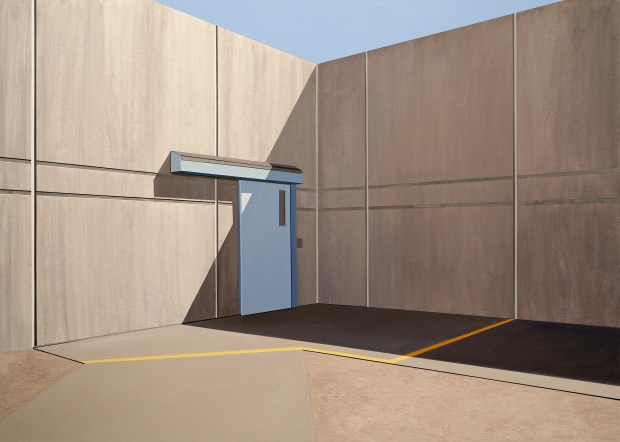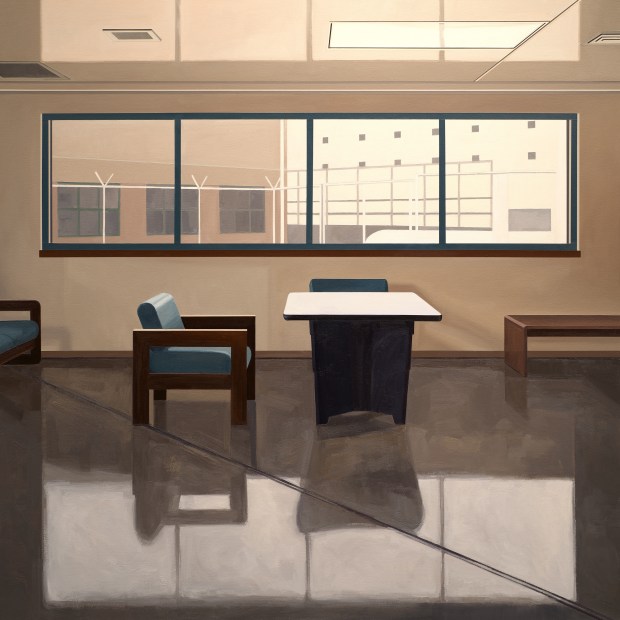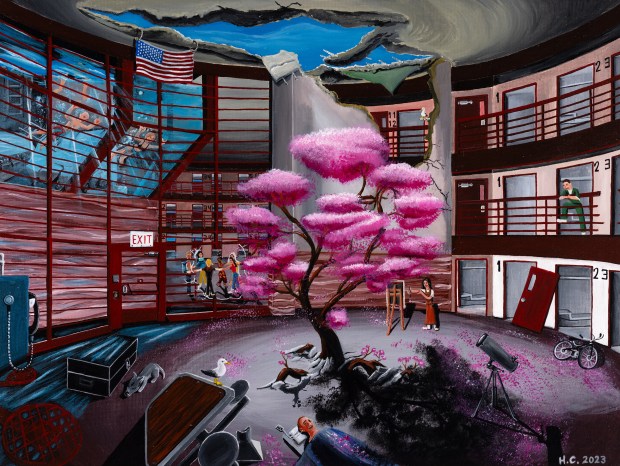Sarah McKenzie is among Colorado’s most respected painters, and she earned that reputation through a most unique body of work: She paints architecture.
McKenzie is known — and has exhibited — far and wide for her precision renderings of built spaces, like residences, commercial structures, construction sites, abandoned factories and more. A few years ago, she began a series capturing exhibition spaces, museums and galleries much like the ones that show her own art. Like nearly all of her work, the paintings are hyper-realistic, and without humans present, yet they still have a soft and personal quality that makes them both recognizable and alluring.
But when she decided three years ago to begin painting prisons, she knew she needed to go deep with the research and alter her usual process. She could not just show up at high-security state facilities, take a few photos, bring them back to her Boulder studio and recreate them in oil and acrylic. She had to work her way inside.

And for the series of paintings now on display at the Museum of Art in Fort Collins, that project took her down a path that changed both the direction of her career and her perspective on the art world itself. She did get inside, and she gained a new understanding of how art can impact everyone who makes it, especially the incarcerated people she met along the way.
The exhibition, “To See Inside: Art, Architecture and Incarceration,” focuses equally on McKenzie’s paintings and on drawings made by those held in government jails. It is a compelling, and organic, group show.
McKenzie’s painting journey included trips to publicly available prisons, such as Alcatraz, the legendary landmark in the San Francisco Bay, and Eastern State Penitentiary, the former “model prison” that is now a popular tourist spot in Philadelphia. She tapped an acquaintance to get access to a youth facility in San Diego. The scenes she created are in the Fort Collins show.

But getting a more intimate view of prisons here in Colorado required gaining special access, and for that, she began by reaching out in 2020 to the University of Denver Prison Arts Initiative, which produces cultural programs for incarcerated people.
“I thought, maybe I can help them file papers in their office as a volunteer and get to know some people,” she said in a recent interview. “I told them that I would do any grunt work. I just needed an introduction.”
Instead, the program asked her to teach drawing to prisoners across the state. Since the coronavirus pandemic was happening, she worked with others to develop a video class that was beamed into jails via closed-circuit video. More than 250 students signed up across 13 facilities.

The students took the class each week, then made drawings of assigned topics. The works were scanned and sent out to evaluators across Colorado, who gave them feedback. McKenzie worked directly with male prisoners at the Fremont Correctional Facility.
As the pandemic subsided, she was able to go directly inside to teach. She gained permission to take photos and was able to start her own painting process.
The result shows the stark realities of prison life. One painting in the exhibition, “Some Days the Sky Is Just a Ceiling,” shows just a corner of the prison yard at the Sterling Correctional Facility, which McKenzie describes as “this kind of vast space, like the size of two football fields, with these two- and three-story high, poured concrete walls in all directions.”
The yard has no windows. “And so you can’t actually see the landscape beyond the prison when you’re in the yard, All you can see is the sky when you look above the walls,” she said. It is a tease to what it might be like to truly experience the outdoors.
Another painting, “Window Blinds,” captures a solitary confinement cell. The space has small rectangular windows but they are covered with blue, metal places that prevent an outside view. McKenzie renders the scene in a straightforward manner, capturing the geometrical patterns of the windows, but also the sense of isolation that exists within the room.
As she made her own work, she also grew to appreciate the prisoner drawings she was seeing. The pieces included in “To See Inside” do reveal an inside view of what daily life is like behind bars.

For example, several prisoners chose to make drawings of their beds and how they use the little personal space they have to express their personalities.
Another common element: prisoners rendering the interiors of the lock-up facilities in black-and-white but changing to full color to represent scenes they might see through a window. One drawing, by Joseph Taylor McGill, shows a simple gray line drawing of an interior prison wall where an imaginary door opens up to reveal a vibrant nature scene outside.
There are also scenes configured with great imagination and loaded with optimism. A drawing by Hector Castillo depicts a dilapidated prison sometime in the far-off future. The jail has been shut down for some time and the walls are open to the outside where the sun is shining and children are playing. In the middle of the space, a giant tree with pink blossoms has grown.
McKenzie believes it is important to show this work in public and she has made a mission of it. She plans to curate future exhibitions, including at the Colorado State Capitol, that will omit her works and feature only pieces by incarcerated or formerly incarcerated Coloradans. She is committed, she said, to making her collaborations with these artists part of her ongoing mission.

But McKenzie’s works, the inside scenes of the facilities, are profound in their own way — both for what they say about how we hold people in captivity, and the power of architecture to shape our attitudes or, as McKenzie puts it, “how it communicates our societal priorities and cultural norms and controls our behaviors as we move through spaces.”
The paintings also represent a rich turn in the career of an important Colorado artist who has taken us along on her very unique journey of exploring built environments. She sees a link between all of her subjects, whether they are office buildings, jails or museums.
“This was actually an extension of my interest in looking at museum spaces and thinking about institutions and institutional architecture,” she said. “I’ve been thinking a lot about this idea of the display of power and the way that both prisons and museums are very invested in that display of power.”
IF YOU GO
“To see Inside” continues through March 17 at the Museum of Art in Fort Collins. 201 S. College Ave. Info: 970-482-2787 or moafc.org.
Ray Mark Rinaldi is a freelance writer based in Denver who specializes in art and music.
This post was originally published on this site be sure to check out more of their content.







